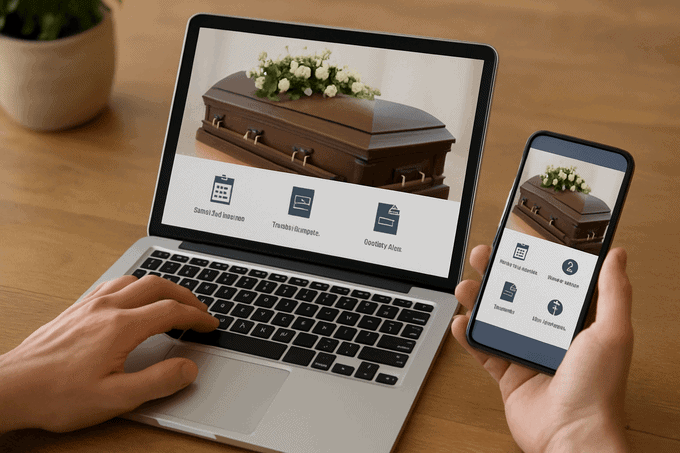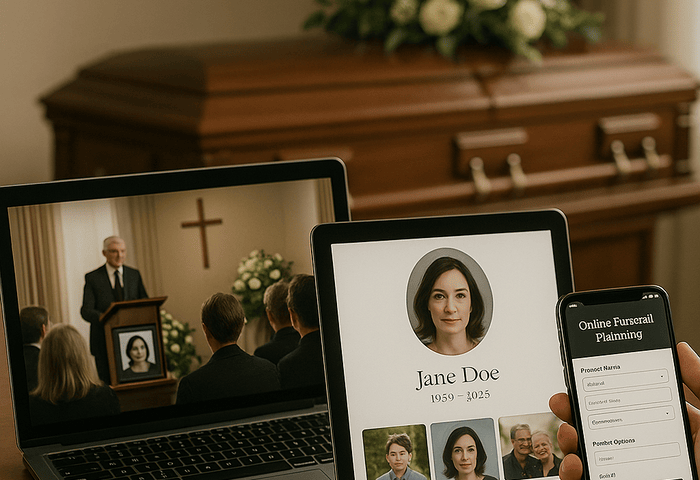Technology Integration in Funeral Homes

Family Support Services at Funeral Homes
June 1, 2025
Types of Funeral Services: Celebration of Life Services
June 1, 2025Funeral homes have always centered around tradition—but tradition alone doesn’t meet every modern need. Families now expect more flexibility, better access, and tools that make the process easier to manage during a difficult time.
Technology offers that balance. Whether it’s streaming a service for relatives overseas or creating a digital memorial that lives on long after the burial, funeral home technology solutions help families stay connected and informed without losing the personal touch.
The shift isn’t just happening—it’s accelerating. Live streaming, video tributes, online guestbooks, and digital planning platforms aren’t extras anymore. They’re becoming standard features families look for when making final arrangements.
Meeting Modern Family Expectations
People grieve differently. They also plan differently. Some want to sit down face-to-face. Others prefer booking everything online. Either way, families want choices that reflect their lives—not systems that force them into outdated processes.
Younger generations are driving much of this change. They expect digital tools. They’re comfortable planning online, sharing links to live-streamed services, and uploading photos for memorial videos. Older relatives appreciate the added access too, especially when travel isn’t an option.
Convenience matters. So does inclusivity. When funeral homes meet both, they serve people better—wherever they are, however they grieve.
Key Technologies Used in Funeral Homes
Funeral homes aren’t just adding technology—they’re rethinking how they support families from first contact through final remembrance. When used well, tech makes services more inclusive, meaningful, and manageable for everyone involved.
Each tool serves a purpose. From livestream links to interactive tribute pages, digital options give families more control, more connection, and more room to grieve their way.
Live Streaming Funeral Services
Live streaming lets family and friends attend a service, no matter where they are. Whether someone’s across the country or unable to travel due to illness or cost, they can still be part of the moment in real time.
Most funeral homes use familiar platforms like Zoom or YouTube. Some offer proprietary systems with password protection, chat features, or replay options for those who can’t join live. During the pandemic, demand surged. Now, it’s become a permanent option many families request—especially for military funerals, international families, or sudden losses.
One Texas-based funeral home saw a 300% increase in livestream use between 2020 and 2023. Families say it helped them feel connected, even from thousands of miles away.
Digital Memorials and Tribute Pages
A digital memorial isn’t just a page—it’s a space to remember, reflect, and share. These pages often include photos, short videos, favorite songs, and written messages from friends and loved ones. Some include interactive guestbooks, donation links, or social sharing tools.
They live online, so anyone can visit anytime. That ongoing access turns a single service into a long-term tribute. Instead of ending at the burial, the memory continues—especially helpful for those processing grief at their own pace.
Tribute pages also give relatives something to pass along. A link shared with someone who couldn’t attend in person becomes a gesture of care and inclusion.
Online Funeral Planning Tools
Planning a service usually requires dozens of phone calls, in-person meetings, and paperwork. Online platforms reduce that load. They let families:
- Book appointments
- Choose service types and packages
- Upload documents
- Submit obituaries
- Make payments securely
That kind of flexibility makes a big difference—especially for working families, adult children managing affairs remotely, or those with limited time.
Accessing those tools 24/7 means decisions don’t have to wait for business hours. Families get more control over the pace and structure of planning.

Audio-Visual Enhancements at Services
Technology also reshapes what happens during the funeral itself. Video tributes, slideshow displays, and upgraded sound systems personalize the experience and help tell a fuller story.
Families often provide old home videos, voicemail clips, or curated photo sets. Staff then create a polished tribute that plays during the service. Some homes include dual monitors, surround sound, or livestream syncing so guests—remote or in person—share the same moment together.
Those touches don’t just modernize the event—they make it more human.
Benefits of Technology Integration for Families and Funeral Homes
Adding new technology isn’t just about convenience—it reshapes how families experience loss, and how funeral homes provide support. The shift toward digital tools creates space for more access, more customization, and stronger service delivery across every stage of planning and memorializing.
Whether it’s a remote guest tuning in from another continent or a family designing a tribute slideshow late at night, modern funeral home technology solutions are helping people grieve on their own terms.
Enhanced Accessibility and Inclusion
Travel isn’t always possible. Health limitations, distance, or financial strain can keep loved ones from attending in person. Technology bridges that gap.
Live-streamed services give everyone a seat, regardless of location. Online guestbooks allow people to leave messages and condolences anytime. Even a short video clip or tribute page helps someone feel included—when otherwise they might’ve missed everything.
Families with multicultural backgrounds or international ties especially benefit from this kind of access. Everyone can stay connected, no matter where they are.
Personalized and Memorable Experiences
A traditional service honors a life. A personalized one tells a story.
Video tributes, custom playlists, digital slideshows, and recorded messages turn static moments into living memory. Tech makes it easier for families to incorporate music, visuals, and shared memories that reflect the person they lost.
Some use home videos. Others create QR codes linking to memorial pages. A few share curated photos with distant relatives who couldn’t be there in person.
These aren’t just nice touches—they’re healing ones.
Operational Efficiency for Funeral Homes
Digital tools help staff work smarter behind the scenes. Online platforms handle appointment booking, service planning, payments, and even obituary submissions in one place.
That reduces errors, shortens response times, and frees up more time for personalized care. When paperwork and logistics don’t dominate the schedule, teams can focus on what matters most—supporting families through their grief.
Automated confirmations, real-time updates, and centralized records also help avoid confusion, especially during high-stress moments.


